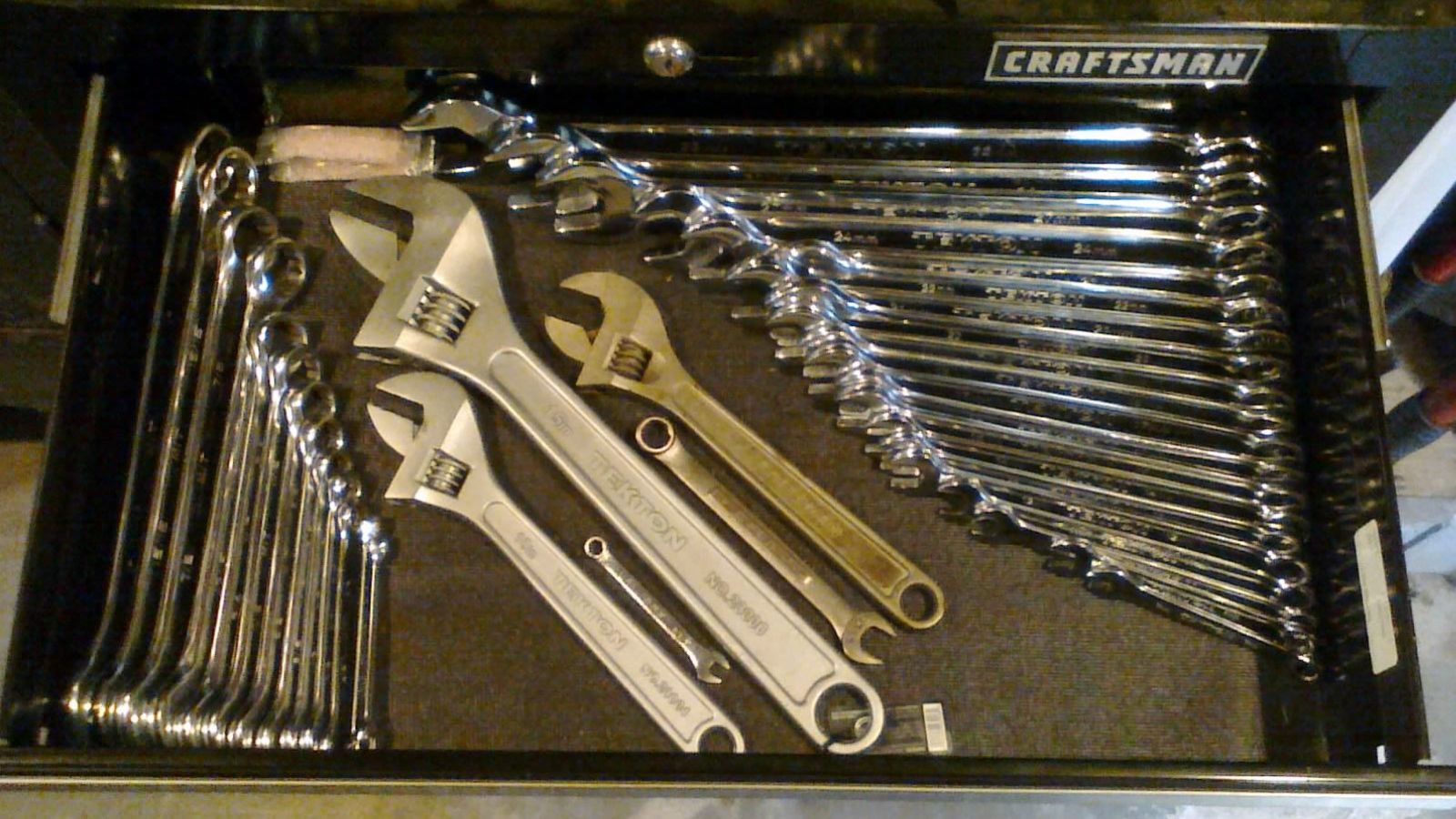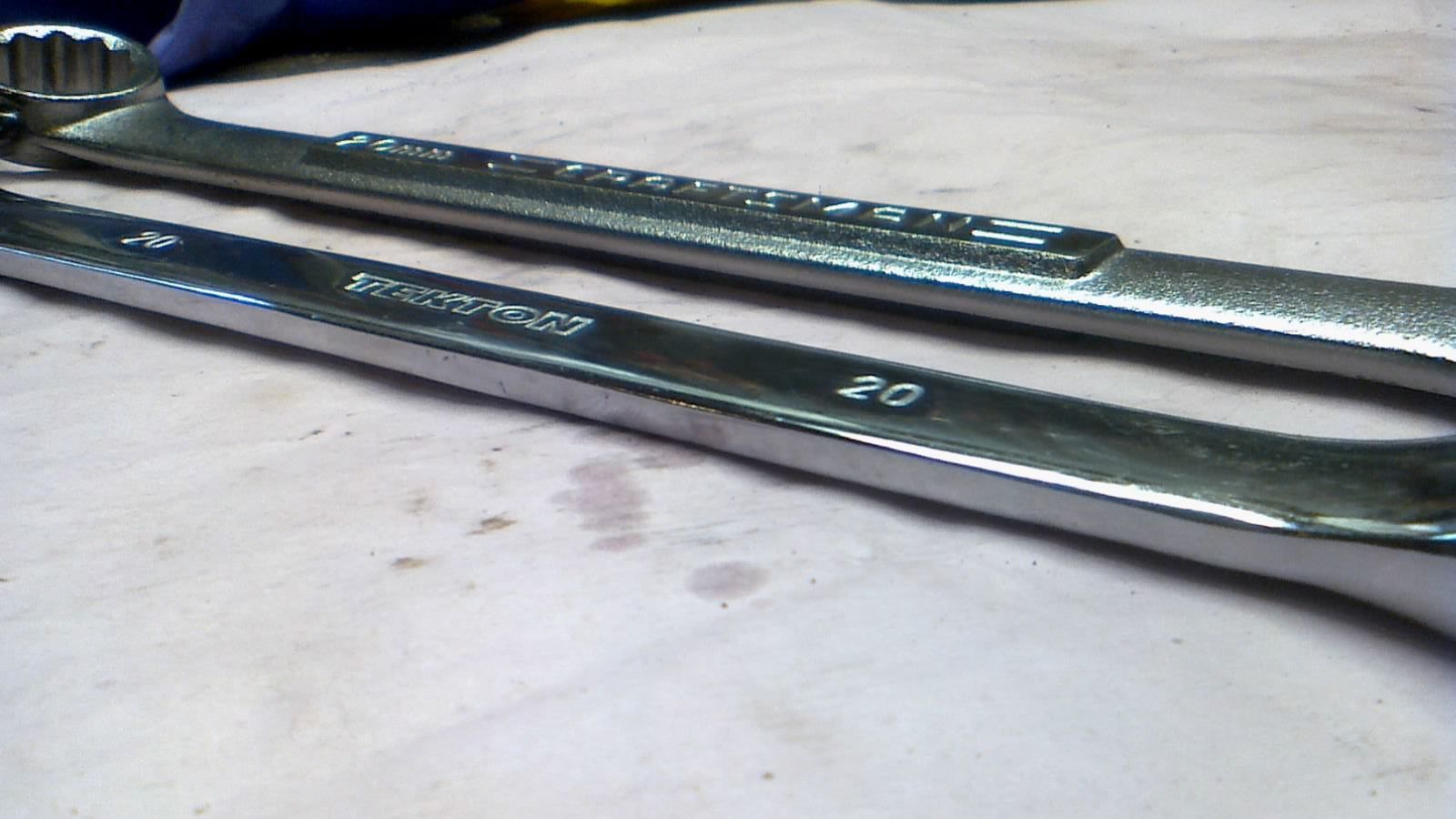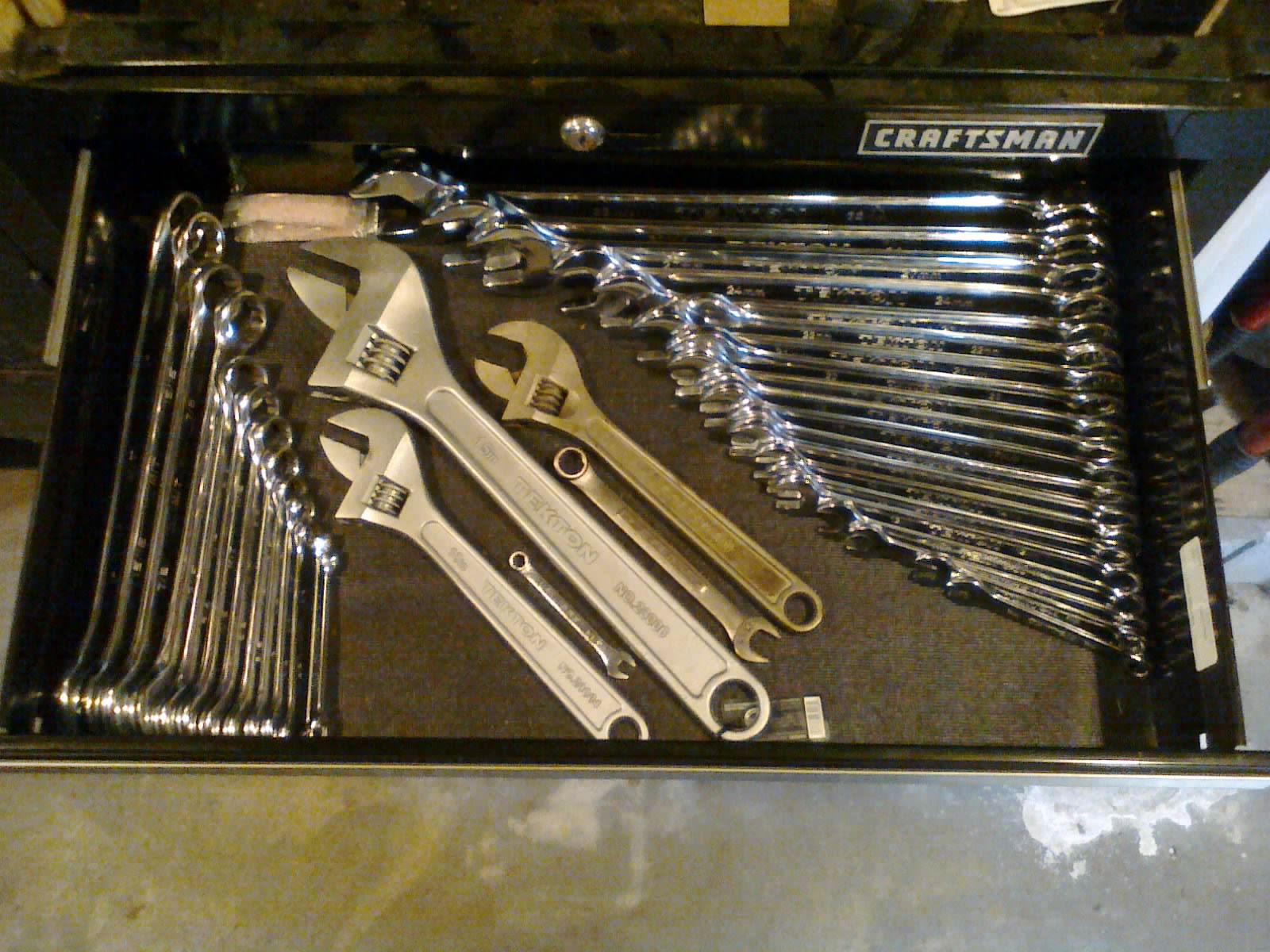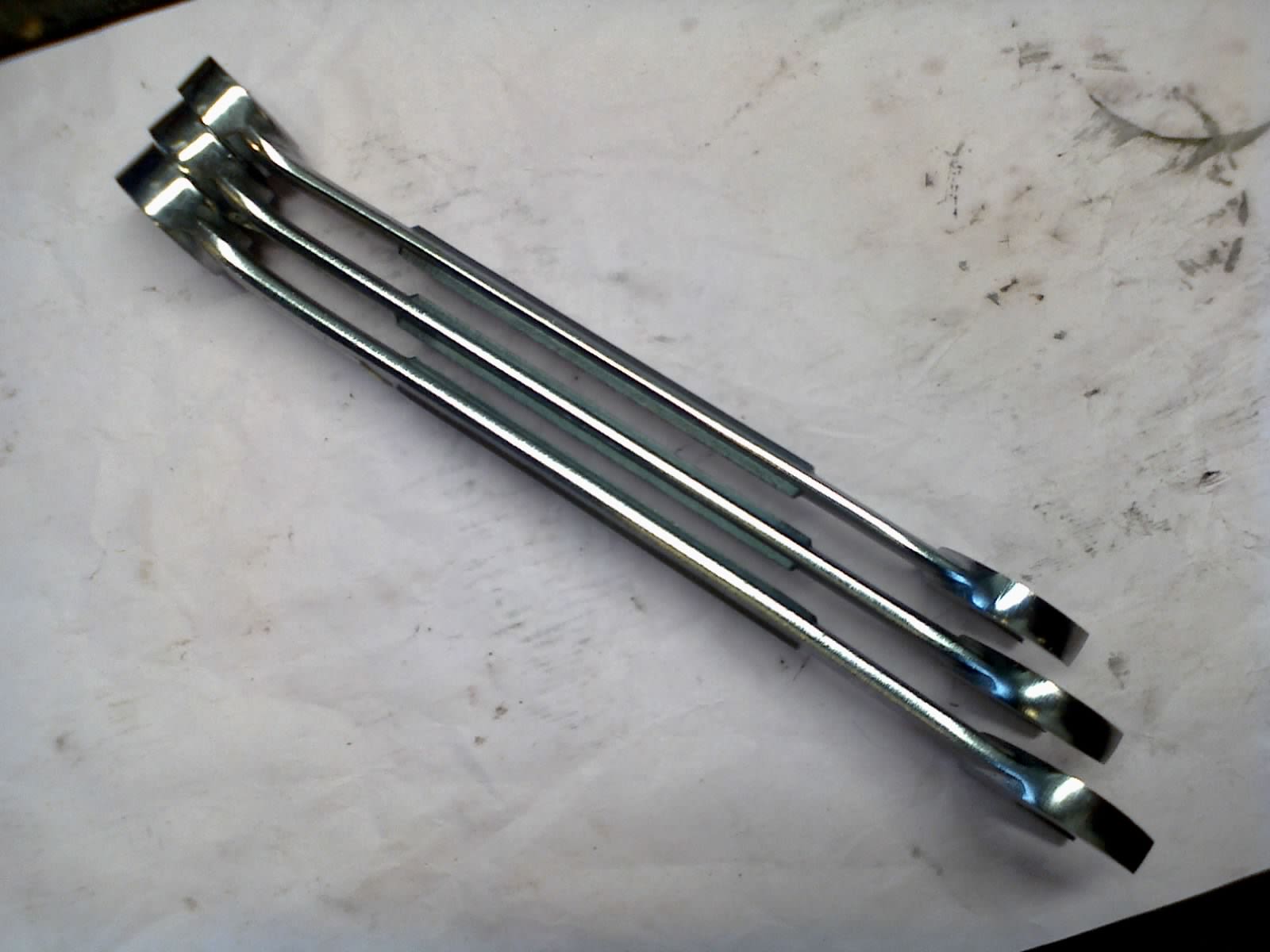
For far too long, I’ve been keeping my combination wrenches in tool rolls. And keeping those rolls in one of my tool chest drawers. Each time I needed a wrench, I’d open the drawer, take a roll out, find a place to unroll it, and fish the size I needed out of it. Well, no more of that nonsense. I’m going to arrange them in the drawer like I should have done a long time ago.
But I don’t feel like spending the money on a “one-size-fits-all” plastic rack. It’s not just the money. I fear that it might not have enough slots for all my wrenches, or I might not like how far away it spaces each wrench, eating up my very limited drawer space. So I’m trying to design my own.
Little did I know how much math this was going to take...
What I’m envisioning is: a simple, long piece of plastic, laid flat in the drawer, more or less perpendicular to the wrenches. Along this piece will be vertical partitions of plastic parallel with the wrenches, creating a slot for each wrench. That way, I can stand the wrenches all on edge in their own slot and be able to pick one out without its neighbor falling over into that space. But I can’t make each slot the same size, lest the bigger wrenches will stand up while the smaller ones lay flat. No, I want them all standing, so that I can use the available drawer space more efficiently.
I don’t want giant gaps between them. Nor do I want the wrenches pinched between the partitions. I want them all to be slightly loose in their respective slots. Of course, the larger the wrench, the thicker the handle, so this means that each slot is going to have different spacing between partitions. Ugh, math.
But first, I need to make sure that this rack can handle differences between brands. I use Tekton wrenches primarily, but have a set of Craftsmans on hand for backup wrenches, in case I need two of the same size, or if one of my Tektons should break (hasn’t happened yet, knock on wood). And even though I’ll be storing my Tektons in this rack, I want to be able to store Craftsmans there later if I ever change my mind.
Just how significant is the difference between brands here? Well, here’s a 20mm Craftsman next to a 20mm Tekton:

See what I mean? Maybe the pic isn’t doing it justice. What you’re looking at here is a Tekton with a 5.5mm thick handle, next to a 9.0mm thick Craftsman. Designing this rack for Craftsmans is going to leave the Tektons with a lot of extra room.
And I’m ok with that. Just as long as none of the wrenches end up lying flat. (TBH, I actually really like the idea of having the wrenches sit at an angle, to make the sizes that much easier to read. But conserving drawer space is more important to me. So I’m going to continue designing this to stand the Craftsmans up, and the leaning Tektons will just be a happy accident.)
Unfortunately, handle thickness is not quite proportional to the nominal wrench size. Compare a 20mm Craftsman to a 10mm from the same set. The 20mm has a handle thickness of 9mm, so how thick is the 10mm? Nope, not 4.5mm. More like 5.5mm.
So at 5.5mm, this 10mm wrench boasts a handle thickness 55% of its nominal size. But a 15mm’s handle measures 7.5mm thick: just 50% of nominal size. The 20mm’s comes in at 45%, and the 25mm at 40%. My 30mm, at about 12.2mm thick, also measures about 40% of its nominal size. So that seems to be where it tapers off.
I thought that this discovery would unlock a relatively simple formula, based primarily on each wrench’s nominal size, that would achieve the perfect spacing between slots. Unfortunately, there’s more to it than that...
Why all this math? Why not just add 1/8" to each wrench’s handle thickness and be done with it? Well you see, I want to maintain some flexibility in how I can arrange these racks in the drawer.
One of the biggest obstacles here is the angled box ends of these combo wrenches. If I line up the open ends against the side of the drawer, I can stack the wrenches closely together. But I don’t know if I’m ready to commit to that. Maybe I’ll want to place the box ends along the edge of the drawer, as seen on the right-hand side of the pic below.

But you see what’s happening? Stacking the wrenches together like that makes a sort of fan shape, and I’d rather keep the wrenches parallel. So to achieve that, I’m going to have to leave some extra room along the handles and open ends.

Yeah, I think it’d look much nicer, having them all parallel.
So I’ve been trying to come up with a formula based on each wrench’s nominal size that will prevent me from having to measure each and every wrench individually to figure out how to space the partitions. The most consistent formula I’ve managed to come up with, that keeps the box ends close together, so far is this:
Take each wrench’s actual thickness, and add its nominal value as a percentage. This yields a space between partitions as follows:
30mm: 12.2mm thickness + 30% = 15.86mm between partitions
25mm: 10.0mm thickness + 25% = 12.50mm between partitions
20mm: 9.0mm thickness + 20% = 10.80mm between partitions
15mm: 7.5mm thickness + 15% = 8.62mm between partitions
10mm: 5.5mm thickness + 10% = 6.0mm between partitions
This leaves a minimal gap between the box ends, spacing the wrenches very close together, without wedging them against one another. Here’s a slideshow of how the above partition spacing formula works out for each wrench:
As you can see, it’s not exact. The larger wrenches are leaning more than the smaller ones.
This formula takes into consideration handle thickness, and accommodates for the angled box ends, which is the main limiting factor among the larger wrenches. It’s less of a problem among the smaller ones though, which allowed me to put them closer together, resulting in the reduced angle.
So I can either proceed with this formula and accept a gradual change in resting wrench angle across the range (which admittedly, wouldn’t look all too terrible), or come up with a new formula that gives the smaller wrenches some extra space to lean, matching the angle of the larger wrenches for a more consistent look.
But wait! There’s still the thickness of the partitions themselves to take into account. I’ve got some scrap polystyrene on hand that I’m looking at using to construct this rack. I’m unsure of its nominal thickness, but its actual thickness (which is arguably more important here) is coming in at right around 0.105" (7/64"), or 2.75mm. That means that the partitions themselves can be factored into these gaps instead of merely bordering them. I can use this to help condense space even further (which is great, considering that when you add up 20 or so partitions, you’re talking about another 2 inches of drawer space).
Or at least, that’s an option among the larger wrenches where the box end is the limiting factor. Among the smaller wrenches, it’s actually the partition thickness itself that grants sufficient spacing for the box ends. Removing that partition thickness from the aforementioned formula takes away too much, and the wrenches can no longer fit. Shaving 2.75mm from the 6.0mm gap for the 10mm wrench won’t work, because the wrench itself is 5.5mm thick. Ugh.
So some of the partitions can take up some of the spacing, but others would have to merely border it after all.
This is obviously way more thought than I expected was going to have to go into this. I wonder if the designers of already-available tool racks already went through all of this in their efforts to make them one-size-fits-all? If they’ve got all of this figured out already, then maybe it’s worth spending the money on them after all.